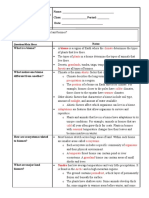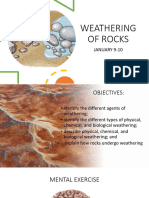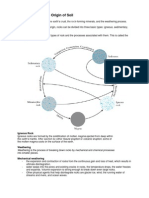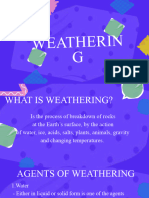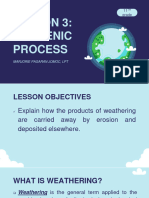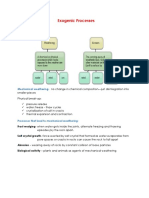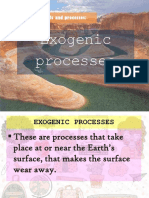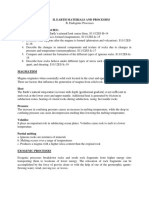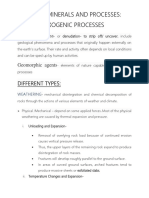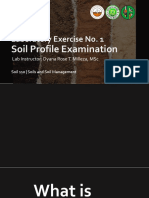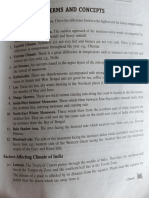Kim Gulapa
Kim Gulapa
Uploaded by
Frederick FajardoCopyright:
Available Formats
Kim Gulapa
Kim Gulapa
Uploaded by
Frederick FajardoCopyright
Available Formats
Share this document
Did you find this document useful?
Is this content inappropriate?
Copyright:
Available Formats
Kim Gulapa
Kim Gulapa
Uploaded by
Frederick FajardoCopyright:
Available Formats
KIMBERLY GULAPA ROCKS
B.S MED-TECH 1
Sedimentary Cycle- A cycle which comprises the weathering of an existing rock, followed by the
erosion of minerals, their transport and deposition, then burial.
THE ROCK CYCLE
1. WEATHERING-is the breakdown of rocks at the earths surface, extremes of temperature, and biological activity. It does not involve the removal of rock material.
THERE ARE THREE TYPES OF WEATHERING
A. PHYSICAL WEATHERING- is caused by the effects of changing temperature on rocks, causing the rock to break apart. The process is sometimes assisted by water. B. CHEMICAL WEATHERING- is caused by rain water reacting with the mineral grains in rocks to form new minerals (clays) and soluble salt. These reactions occur particularly when the water is slightly acidic. C. BIOLOGICAL WEATHERING - living organisms contribute to the weathering process in many ways: Trees put down roots through joints or cracks in the rock in order to find moisture. As the tree grows, the roots gradually prize the rock apart. Many animals, such as these Piddock shells, bore into rocks for protection either by scrapping away the grains or secreting acid to dissolve the rock. Even the tiniest bacteria, algae and lichens produce chemicals that help break down the rock on which they live, so they can get the nutrients they need. 2. EROSION AND TRANSPORT- Erosion is the process by which soil and rock particles are worn away and moved elsewhere by gravity, or by a moving transport agent-wind, water or ice. -Transport refers to the processes by which the sediment is move along-for example, pebbles rolled along a river-bed or sea shore, sand grains whipped up by wind, salt carried in solution. 3. DEPOSITION OF SEDIMENT- Deposition is the laying down of sediment carried by wind, water, or ice. Sediment can be transported as pebbles, sand and mud, or as salt dissolved in water. Salts may later be deposited by organic activity (ex. as sea-shells) or by evaporation. 4. BURIAL AND COMPACTION- Compaction happens when sediments are deeply buried, placing them under pressure because of the weight of overlying layers. This squashes the grains together more tightly.
5. DEFORMATION AND METAMORPHISM- the huge forces that move continents stretch and squash parts of the Earths crust, generating earthquakes and building mountains. They cause rocks near the surface to be fractured and faulted. At greater depth, the heat and pressure involved can cause folding and/or metamorphism. 6. MELTING-where plates move apart, the hot rock of the Earths mantle layer gets closer to the surface and begin to melt, forming runny basalt magma. 7. CRYSTALLIZATION OF MAGMA- the rate at which magma cools controls the grain size of the igneous rock that is formed. More rapid cooling produces finer-grained rocks. 8. UPLIFT-this is the movement of rock beneath the earths crust to the surface and those after sometimes weathering occurs and the rock cycle process starts again.
You might also like
- Metamorphic, Igneous and Sedimentary Rocks : Sorting Them Out - Geology for Kids | Children's Earth Sciences BooksFrom EverandMetamorphic, Igneous and Sedimentary Rocks : Sorting Them Out - Geology for Kids | Children's Earth Sciences BooksNo ratings yet
- Cornell Notes - Land Biomes and Aquatic Ecosystems Filled in VersionDocument6 pagesCornell Notes - Land Biomes and Aquatic Ecosystems Filled in Versionapi-307861748No ratings yet
- Module 3 Exogenic ProcessesDocument3 pagesModule 3 Exogenic ProcessesNicole LeriaNo ratings yet
- Exogenic ProcessDocument4 pagesExogenic Processkhayceemeade2No ratings yet
- Earth Science ReviewerDocument13 pagesEarth Science Reviewerrichelporras84No ratings yet
- Endogenic and Exogenic ProcessesDocument13 pagesEndogenic and Exogenic ProcessesJohndee Mozart Dela CruzNo ratings yet
- Local Media1662112214919609286Document7 pagesLocal Media1662112214919609286Kimberly Grace guingabNo ratings yet
- Lesson 1Document3 pagesLesson 1MJ LontocNo ratings yet
- Endogenous and Exogenous P Rocesses: Mr. L.A - Fronda, LPTDocument26 pagesEndogenous and Exogenous P Rocesses: Mr. L.A - Fronda, LPTMeann OberioNo ratings yet
- WEATHERINGDocument3 pagesWEATHERINGalvaridajoannah905No ratings yet
- Q2-W1 WeatheringDocument60 pagesQ2-W1 Weatheringlacaron.kurtalexanderNo ratings yet
- Weathering and ErosionDocument2 pagesWeathering and ErosionShekaina Faith Cuizon LozadaNo ratings yet
- Weathering StudentsDocument32 pagesWeathering Studentsriane6262No ratings yet
- Exogenic ProcessesDocument40 pagesExogenic ProcessesKristineMaeFernandezCarmeloNo ratings yet
- Soil Mechanicsclass 1Document2 pagesSoil Mechanicsclass 1SUNILKHUNTIA1988No ratings yet
- Earth and Life ScienceDocument3 pagesEarth and Life SciencekyrograpixNo ratings yet
- Earth ScieDocument5 pagesEarth ScieArham GutocNo ratings yet
- Exogenic Processes: WeatheringDocument56 pagesExogenic Processes: WeatheringVicki Punzalan100% (1)
- WeatheringDocument17 pagesWeatheringacorbashleyNo ratings yet
- Lesson 5. Endogenic and Exogenic ProcessesDocument27 pagesLesson 5. Endogenic and Exogenic ProcessesMa Melissa DelavinNo ratings yet
- Form 2 Landforms 1Document10 pagesForm 2 Landforms 1makatepanashe1No ratings yet
- WeatheringDocument23 pagesWeatheringAzu RiteNo ratings yet
- Chapter 2 Lesson 3 Exogenic ProcessDocument30 pagesChapter 2 Lesson 3 Exogenic Process綾瀬No ratings yet
- Unit 6, Weathering, Erosion, and DepositionDocument6 pagesUnit 6, Weathering, Erosion, and DepositionYohana ChuaNo ratings yet
- Brown and Green Scrapbook Sustainability and Ecology Presentation - 20240206 - 042133 - 0000Document21 pagesBrown and Green Scrapbook Sustainability and Ecology Presentation - 20240206 - 042133 - 0000rafaelmapatac3No ratings yet
- WeatheringDocument4 pagesWeatheringagrawalrajni2No ratings yet
- Exogenic and Endogenic Processes NotesDocument10 pagesExogenic and Endogenic Processes NotesMargaret SesaldoNo ratings yet
- Exogenic Processes: Earth Materials and ProcessesDocument41 pagesExogenic Processes: Earth Materials and Processesanon_26027812No ratings yet
- Exogenic ProcessesDocument41 pagesExogenic Processesambionred109319No ratings yet
- Lesson 1: Exogenic ProcessesDocument5 pagesLesson 1: Exogenic ProcessesSelene HmpNo ratings yet
- Exo and EndogenicDocument6 pagesExo and Endogenickc.jarobillaNo ratings yet
- Earth Science q2 w1Document15 pagesEarth Science q2 w1Mykhaela Louize GumbanNo ratings yet
- Weathering and Erosion (Summary)Document4 pagesWeathering and Erosion (Summary)John Mico GacoNo ratings yet
- III. Earth Materials and Processes (Endogenic Processes)Document5 pagesIII. Earth Materials and Processes (Endogenic Processes)Jenalyn JavierNo ratings yet
- 11 - Q2 Earth ScienceDocument2 pages11 - Q2 Earth ScienceCJNo ratings yet
- External Earth's ProcessesDocument10 pagesExternal Earth's Processesshannon.tuan02No ratings yet
- Exogenic Process HandoutsDocument6 pagesExogenic Process HandoutsMG GadonNo ratings yet
- Earth Science Second Quarter (2)Document11 pagesEarth Science Second Quarter (2)Stephenjohn GomezNo ratings yet
- External Forces Shaping The EarthDocument11 pagesExternal Forces Shaping The EarthJesse Ramroop100% (1)
- earth-science-notes-q2-1 (1)Document4 pagesearth-science-notes-q2-1 (1)Miraculous 022No ratings yet
- G11 Q2 Ear-Sci ReviewDocument29 pagesG11 Q2 Ear-Sci ReviewMonisa MisogNo ratings yet
- G3 Weathering and SoilsDocument22 pagesG3 Weathering and SoilsJJNo ratings yet
- Geographical Processes Earth ScienceDocument4 pagesGeographical Processes Earth ScienceoctavianojanineNo ratings yet
- Earth and Life Quiz 6 ReviewerDocument2 pagesEarth and Life Quiz 6 Revieweririshpajarillaga13No ratings yet
- presentation 2024- weatheringDocument44 pagespresentation 2024- weatheringAbdinasir Ahmed MohamedNo ratings yet
- ReviewerDocument16 pagesReviewerMark OximasNo ratings yet
- Presentation 085135Document22 pagesPresentation 085135SultanNo ratings yet
- Weathering Wps OfficeDocument3 pagesWeathering Wps OfficeNot TogeNo ratings yet
- Earth Science Q2 Weathering Internal Heat SourceDocument3 pagesEarth Science Q2 Weathering Internal Heat SourceJoan Vito CruzNo ratings yet
- WEATHERINGDocument3 pagesWEATHERINGMarilou Chalanao EstebanNo ratings yet
- Concept of Weathering Processe 2Document9 pagesConcept of Weathering Processe 2chikaNo ratings yet
- Exogenic Processes - WeatheringDocument65 pagesExogenic Processes - WeatheringlynangelaalmacenNo ratings yet
- 9 Layers of RocksDocument7 pages9 Layers of Rockskristeldevera52No ratings yet
- Q1 Week2Document82 pagesQ1 Week2weebmyphone11No ratings yet
- Geomorphology D.D.M.Document25 pagesGeomorphology D.D.M.Tafadzwa ChavarikaNo ratings yet
- Els Lc11 Lc12Document1 pageEls Lc11 Lc12Ana Maria Gerson TongcoNo ratings yet
- Eath Science LowensDocument5 pagesEath Science Lowensnglc srzNo ratings yet
- Exogenic Process ReviewerDocument1 pageExogenic Process ReviewerSharlize Veyen RuizNo ratings yet
- Earth Science Q2 Week1Document10 pagesEarth Science Q2 Week1MCAPUZ, MARK JOHN, V.No ratings yet
- Exogenic Process EalsDocument4 pagesExogenic Process EalsSamantha EspinoNo ratings yet
- 16 3 Shoreline Features and ProcessesDocument23 pages16 3 Shoreline Features and ProcessesRoland Rawlins IgaborNo ratings yet
- t5 6 NotesDocument3 pagest5 6 Notesapi-645843745No ratings yet
- Planet EarthDocument33 pagesPlanet EarthTora V.No ratings yet
- Complete The Text Below With Words From The BoxDocument2 pagesComplete The Text Below With Words From The BoxAlexandraSochircaNo ratings yet
- Greenhouse Gases PPT 1Document20 pagesGreenhouse Gases PPT 1SparshoNo ratings yet
- Asia VegetationDocument17 pagesAsia VegetationMarie Sachie Mitsui Padillo Turiano92% (12)
- FAO 2019 - Forests - Nature-Based Solutions For WaterDocument88 pagesFAO 2019 - Forests - Nature-Based Solutions For WaterSofiDuendeNo ratings yet
- The Seasons of The Year: Public School 155Document8 pagesThe Seasons of The Year: Public School 155Regner Muñoz BarahonaNo ratings yet
- Exercise No. 1 Soil Profile ExaminationDocument44 pagesExercise No. 1 Soil Profile ExaminationJoyce BaclayonNo ratings yet
- Climate Class 10 NotesDocument12 pagesClimate Class 10 Notesmiss.avika13No ratings yet
- Interactions in The EnvironmentDocument29 pagesInteractions in The EnvironmentJuan ReyesNo ratings yet
- Flood Risk Analysis in Illu Floodplain, Upper Awash River Basin, EthiopiaDocument118 pagesFlood Risk Analysis in Illu Floodplain, Upper Awash River Basin, Ethiopiaمهندس ابينNo ratings yet
- PROJECT REPORT DrainageDocument42 pagesPROJECT REPORT DrainageYUdistiraa KunNo ratings yet
- Jennifer Obarinde Revised WorkDocument25 pagesJennifer Obarinde Revised WorkAdetayoNo ratings yet
- Romania Relief - LANDER 2016 - Part9Document2 pagesRomania Relief - LANDER 2016 - Part9Anonymous SNEL2bNo ratings yet
- Math FA-2Document23 pagesMath FA-2carjunonlineNo ratings yet
- USACE - Dam Inspection Guideline ChecklistDocument23 pagesUSACE - Dam Inspection Guideline ChecklistRaffaele MarinoNo ratings yet
- Coral ReefsDocument17 pagesCoral ReefsTrail JalilNo ratings yet
- Volcanoes Definition TypesDocument62 pagesVolcanoes Definition TypesNota BelzNo ratings yet
- F.2Geog NoteDocument5 pagesF.2Geog Notecm6bnmyp65No ratings yet
- Ahmedabad - Gandhinagar Twin City, Gujarat: P.R.Gupte, CGWB, AhmedabadDocument11 pagesAhmedabad - Gandhinagar Twin City, Gujarat: P.R.Gupte, CGWB, Ahmedabaddeepansha tyagiNo ratings yet
- Week 1 Disaster-Readiness-and-Risk-ReductionDocument20 pagesWeek 1 Disaster-Readiness-and-Risk-ReductionShen EugenioNo ratings yet
- Alvarado 2017Document12 pagesAlvarado 2017Rubens HayekNo ratings yet
- Mid Semester WS14Document7 pagesMid Semester WS14Cristina Maria MoldovanNo ratings yet
- Geo Term-2 Denudation 1Document11 pagesGeo Term-2 Denudation 1Tvisha AgarwalNo ratings yet
- WRF CLMDocument21 pagesWRF CLMenso2010No ratings yet
- Runoff Modeling Using SWAT Hydrological Model For Ghataprabha BasinDocument5 pagesRunoff Modeling Using SWAT Hydrological Model For Ghataprabha BasinIJASRETNo ratings yet
- Natural Resourcesandtheir Ecosystem Services Chapter MCand Team 2020 Bookby DR AMitraand TeamDocument12 pagesNatural Resourcesandtheir Ecosystem Services Chapter MCand Team 2020 Bookby DR AMitraand Teamshruti ChandrakarNo ratings yet
- Esci344 Lesson08 Tropical Weather SystemsDocument9 pagesEsci344 Lesson08 Tropical Weather SystemsSajjad Husham SalihNo ratings yet

